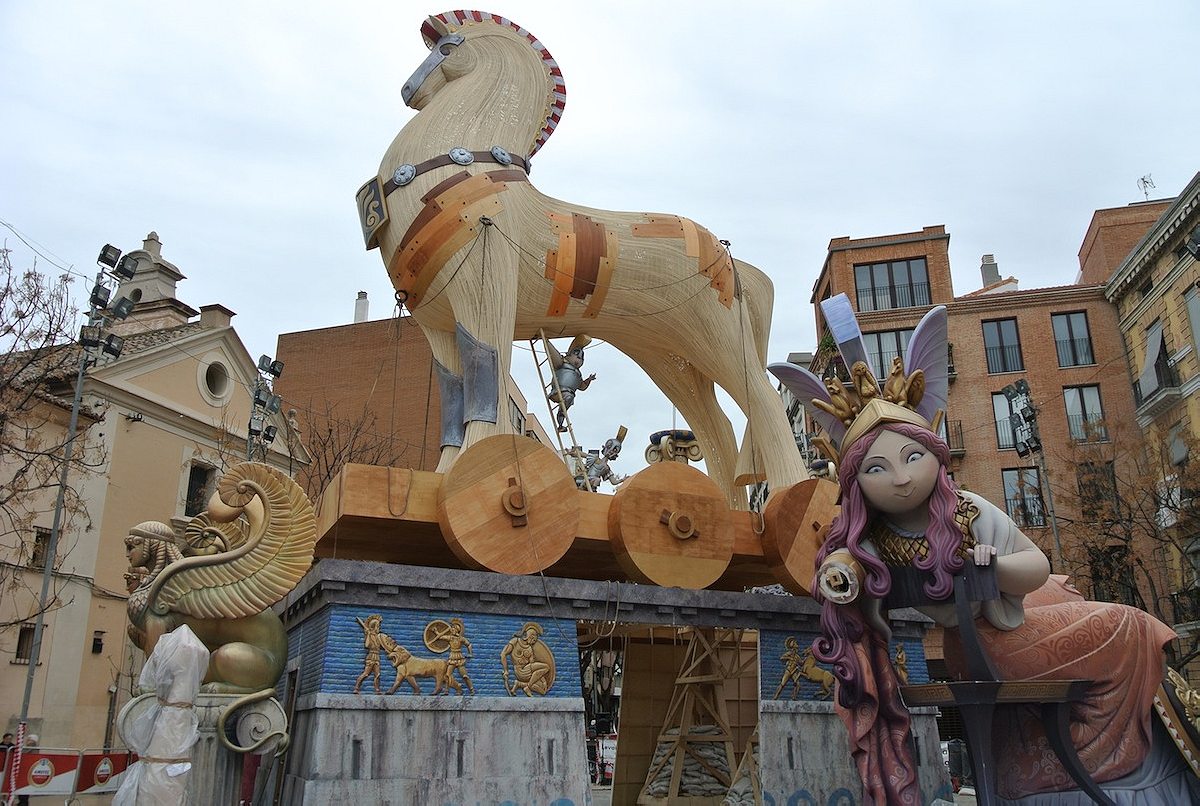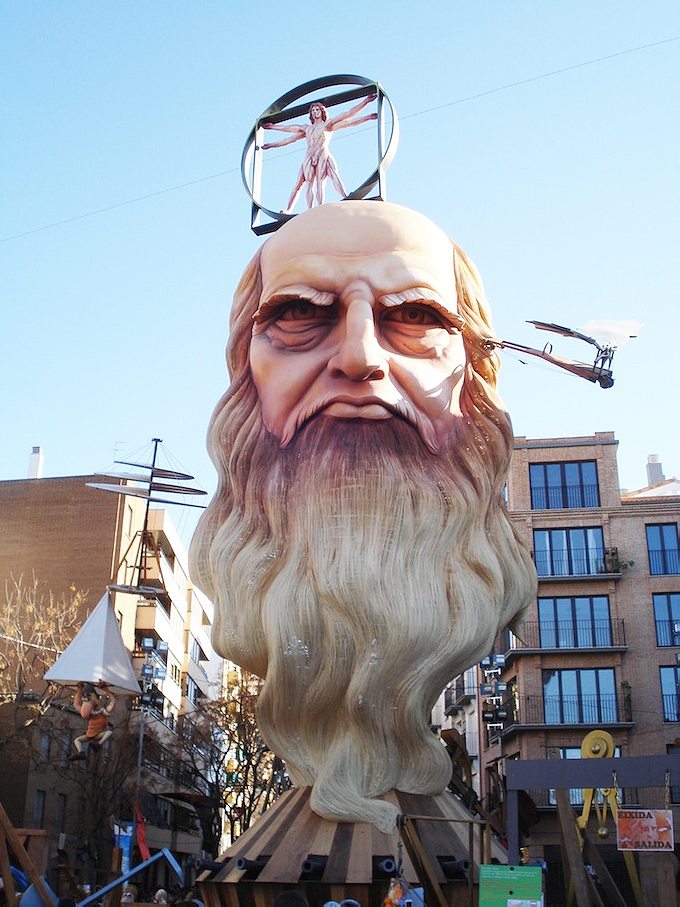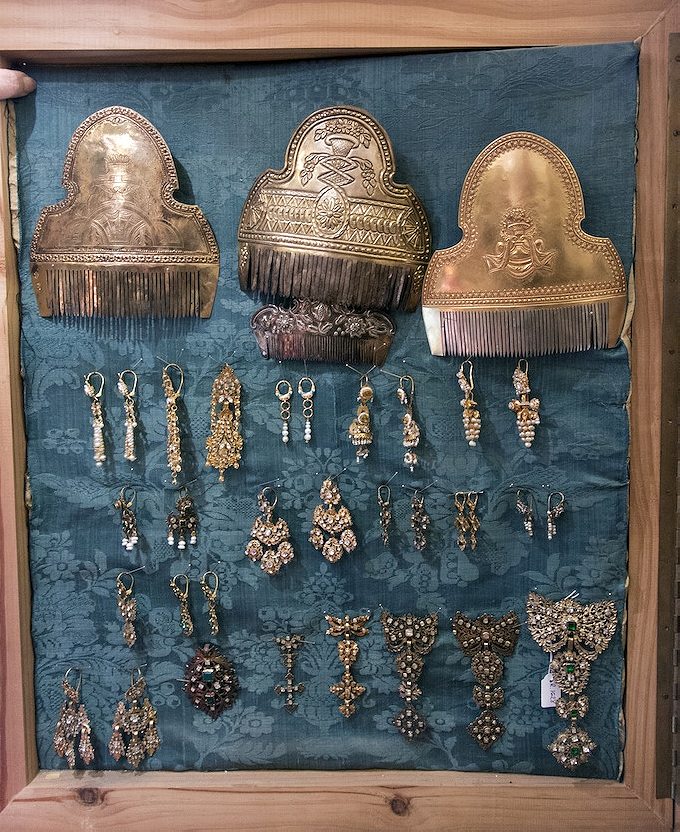Xaq Frohlich visits Valencia during Fallas, a colorful festival that marks the arrival of spring.
For four days in March, Valencia is on fire. Fallas—a festival of street sculptures, fireworks, electric light displays, and neighborhood paella parties, running March 16 to 19—transforms the city into a pulsating carnival of day parades and nightlong revelry that marks the end of the winter and arrival of spring. Marching bands featuring traditional Valencian instruments play the popular riffs of ‘Paquito el Chocolatero.’ Parades of falleras, the female protagonists of the festivities dressed in flowing, traditional silk dresses, carry flowers in homage to the Virgin Mary.
The streets smell of fried dough from food stands selling local pastries. Late night crowds gape at elaborate, sometimes mammoth falla art monuments—the sculptures and centerpieces of the festival, over 700 of them spread across 350 different neighborhoods throughout the city, each with their own party. Each night features a fireworks show after midnight over the Valencia riverbed park: First, la nit del foc—the night of fire—the biggest fireworks display, followed by la nit de la cremà—the night of the burning—when across the city’s many neighborhoods the falla monuments go up in flames.
For the million visitors who double the city’s population that week, Fallas is a dazzling celebration whose intensity is difficult to process. For the people who prepare the festival, the neighborhood falleros who organize it, and the artists and specialists who comprise it, Fallas is the culmination of a year-long collaboration and effort.

The Fallas festival has numerous origin stories. It’s often connected to ancient European traditions of building bonfires around the Spring equinox. But most falleros trace its beginnings to a celebration of Saint Joseph, the carpenter guild’s Saint’s Day. Valencian carpenters would mark March 19 by cleaning their shops and burning the old wooden cinders out on the streets. Neighbors often pitched in. As early as the 18th century, the wooden scraps were dressed up as figures known as ‘ninots’ in small morality plays, often incorporating neighborhood gossip or critiques of local government policies.
By the late 19th century, these figurines and monuments evolved into the centerpieces of a more sustained, day-long street festival, with artists who specialized in building them. But the Franco dictatorship changed the community of artists and the spontaneous informality of the holiday. After the Civil War it was illegal for groups to meet in private. In 1943, under the leadership of Regino Mas, an influential fallero artist in this period widely considered a founder of the modern craft, the artists formed the Fallero Artisans Guild. Concept sketches for fallas had to be registered in advance. It was a way for the regime to exercise control, but also a way for artists to gain legitimacy. Despite this evolution, satire and light-hearted criticism remained a key element of fallas, one that survived even Spain’s dictatorship.

hen I met Marisa Falcó, one of a new generation of fallero artists, in her workshop, she was shaving down pieces of polystyrene foam to take the form of the ninots, then plastering them with papier-mâché. She and fellow artist Paco Pellicer run the workshop Fet d’Encàrrec, working on fallas part of the year, and stage and theater productions the rest. These ninots pieces will be joined together to build the falla they were making for the nearby Plaza del Ángel square in Valencia’s El Carmen neighborhood. Their falla this year will be a medium-sized monument, geared towards children.

The technique used by fallero artists changed dramatically in the late 1990s, when they began to use the more malleable and cheaper polystyrene to build fallas in place of wood and cardboard, making it easier to build monuments multiple-stories tall and with greater variety and detail. This new medium, along with digital rendering, has compelled artists to adapt their skillsets. Still, because artists need to know the limitations of the materials, as well as what kinds of monument will remain standing and what burns the best, the profession continues to value workshop experience over architecture or engineering degrees.

A falla is essentially a series of figurines arranged together in scenes to tell an overall story, much the way a comic strip does through a series of panels. The goal of the humor is heavily satirical, playful and poignant. Fallas take many shapes and forms and are accountable to public tastes, not critics. Artists hope to win prizes judged by non-professional juries and tend to focus on eye-catching colors, size, and detail over sophistication and artistic originality. It is at times childish in spirit, almost like a Disney cartoon, but at other times it can be crude, bordering on offensive. Many ninots are inspired by celebrities or star football players. Some are tasteless and of modest design, but many are beautiful, and it can be painful knowing they’ll ever be touched by a flame.

The traditional fallera dress has evolved over the centuries, accumulating decorative curiosities and adornments from different periods. Victoria Liceras is a collector of traditional Valencian outfits who owns a fallera dress shop, El Siglo XVIII, in the city center. Her shop specializes in recreations of 18th-century fashions. Victoria says a fallera dress is not truly a traditional outfit, but includes historical elements mixed with whatever Valencians find fashionable today. (There are also fashions in the men’s traditional attire, but they generally take a back seat to the women’s.)

The fallera mayor is the figurative queen of Fallas. Each neighborhood group (called a casal) elects a young woman (‘fallera mayor’) and a girl (‘fallera mayor infantil’) to be the head of that year’s neighborhood festivities, and the city selects one young woman and one girl to lead citywide events. The dresses are modeled after those historically worn by aristocrats, but include an apron suggesting a workingwoman. Quality dresses are made of silk, a fabric of great historical importance in Valencia given that the city was a key trading port for the silk exchange between Europe and the East for centuries.

The least traditional signature element of the fallera outfit is the sash the Fallas queens wear across the chest, reminiscent of Miss America pageants. It is a vestige of Spain under the Franco dictatorship, reflecting a militaristic style that emphasizes rank and marching displays. (Recently there has been a movement among falleras to steer away from wearing the sash and return to a more historical look.) It was during the post-war period, under Franco’s repression, that Fallas added many of its formal parade traditions, principally la Ofrenda—the pilgrimage each casal makes on March 17 or 18. Falleras march in file to bring their flower offerings to the Virgin Mary.

Despite its militaristic undertones, la Ofrenda is now one of the most emotional events during Fallas. Falleras cry as they deliver their bouquets of flowers to the feet of the Virgin. The design of the robe of flowers on the towering scaffolding of the Virgin is breathtaking in detail, as elaborate as the floral patterns of a fallera dress. During Fallas, the Virgin Mary is perhaps the only thing that does not burn.

Valencia ya huele a pólvora! is a familiar cry in the city as March approaches—“Valencia has started to smell of gunpowder.” The streets begin to feel like a war zone. Firecrackers explode in all quarters with increasing frequency as the 19th approaches. Buildings shake and car alarms wail. Valencians are infamous throughout Spain for their love of fire and fireworks.
In the afternoons, the city explodes with mascletàs—a five-minute acoustical fireworks display called a “symphony of gunpowder.” Jose Crespo is the youngest pyrotechnic specialist to have done a mascletà in the town square, where the shows are performed every afternoon throughout the festival. Crespo was 17 when his father died more than twenty years ago, in February—Fallas season. That year, Crespo worked with his family to fulfill his father’s business contracts, and the following year, in 1992, at the age of 18, he conducted his first solo mascletà in the town hall square, a high honor for Valencian pyrotechnic companies. He has been performing the shows ever since.
Jose explains that a mascletà takes place in three phases. It begins with a ‘traca’, a string of snapping fireworks that sets off an aerial show with streams of smoke. This is followed by ground fireworks composed of controlled stop silences, punctuated by thunderous booms. The final phase is, the ‘terremoto’—the earthquake, during which about half of the total gunpowder will be used. It builds up to a thunderous roar that gets louder each second. Locals warn newcomers to keep their mouths open, so the vibrations don’t pop their eardrums.

On March 19, La nit de la cremà, the city becomes one great bonfire. Hundreds of fallas are lit across the city and the surrounding region. “Each year it’s a challenge,” one fallero explained to me, but the fire is important because “it burns away all the bad that has accumulated over the year.” The burning acts as a catharsis. Everyone then converges at the city center to watch the bonfire of the city’s official falla, the last to burn, accompanied by more fireworks and fanfare, marking the close of that year’s festival. When it finishes, the silence in the streets at 2 a.m. is almost as jarring as the revelry the night before.
I’ve lived in Valencia for half a decade and can’t help admiring the way falleros spend hundreds of hours and thousands of euros on their monuments, only to burn them in the end. It suggests some kind of anarchical or self-destructive impulse in the Valencian character. It is the most common question I am asked by visitors: how can they burn such beautiful works of art? But for the falleros, when the last ember has burned and the last tear shed by the fallera mayor, they are already looking ahead to next year, already thinking of how they can improve on this year’s festivities. As Marisa Falcó puts it, “It has to burn, because until it burns we can’t think about next year’s project.”